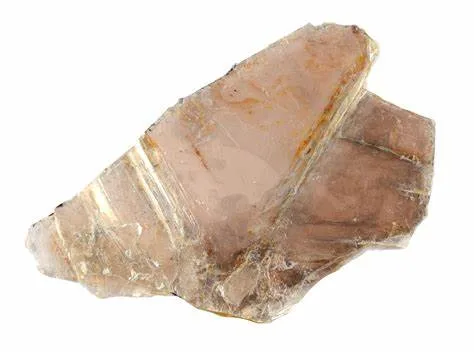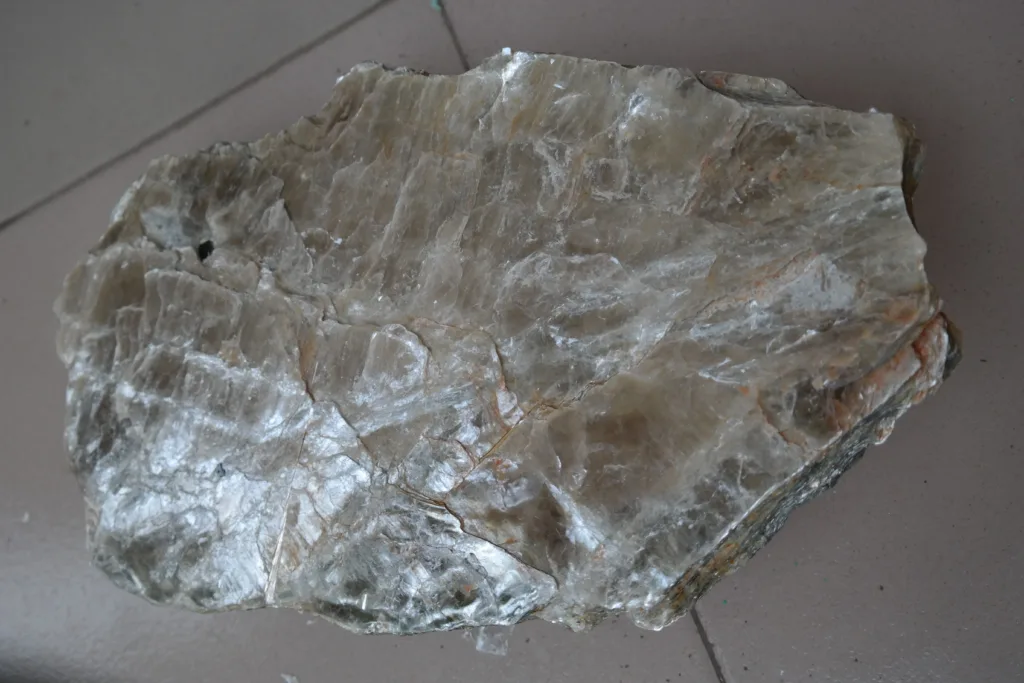Muscovite is a common mineral that belongs to the mica group. It is a silicate mineral that is characterized by its thin, sheet-like structure. Muscovite is composed of potassium (K), aluminum (Al), silicon (Si), and oxygen (O) atoms arranged in sheets, and it is known for its excellent cleavage, which allows it to be easily split into thin, flexible sheets. These sheets are often transparent to translucent and have a pearly luster.



Name: From \Muscovy glass,” for an occurrence in the old province of Muscovy, Russia.
Polymorphism & Series: 2M1 ; 1M, 3A polytypes; interstrati¯es with vermiculite, paragonite, montmorillonite.
Mineral Group: Mica group
Association: Quartz, plagioclase, potassic feldspar, biotite, tourmaline, topaz
Diagnostic Features: Characterized by its highly perfect cleavage and light color. Distinguished from phlogopite by not being decomposed in sulfuric acid and from lepidolite by not giving a crimson flame.
Contents
Properties of Muscovite

Muscovite is a mineral with distinctive chemical, physical, and optical properties. Here are the key characteristics in each of these categories:
Chemical Properties:
- Chemical Formula: Muscovite is a potassium aluminum silicate mineral. Its chemical formula is typically written as KAl2(AlSi3O10)(OH)2. This formula represents the arrangement of potassium (K), aluminum (Al), silicon (Si), oxygen (O), and hydroxyl (OH) ions in its crystal structure.
- Composition: Muscovite is composed of sheets of aluminum-oxygen tetrahedra bonded to sheets of silicon-oxygen tetrahedra, with potassium ions located between the layers. The presence of aluminum in its structure is a characteristic feature distinguishing muscovite from other mica minerals like biotite.
Physical Properties:
- Crystal System: Muscovite crystallizes in the monoclinic crystal system. Its crystals are often tabular or sheet-like due to its perfect basal cleavage.
- Cleavage: Muscovite exhibits perfect basal cleavage, which means it can be easily split into very thin, flexible sheets along one direction. This property is responsible for its characteristic sheet-like appearance.
- Hardness: Muscovite has a Mohs hardness of approximately 2.5 to 3. This relatively low hardness makes it a relatively soft mineral.
- Luster: Muscovite has a pearly to vitreous (glassy) luster when its sheets are separated.
- Color: Muscovite can be colorless, white, or pale shades of pink, brown, green, or yellow. It can also display pleochroism, meaning it may exhibit different colors when viewed from different angles.
Optical Properties:
- Transparency: Muscovite is transparent to translucent, allowing light to pass through its thin sheets. This property is exploited in certain optical and electronic applications.
- Refractive Index: The refractive index of muscovite ranges from approximately 1.559 to 1.597, depending on the wavelength of light and the specific composition of the mineral sample.
- Birefringence: Muscovite is typically birefringent, meaning it can split light into two polarized rays that travel at different speeds through the mineral, resulting in interference patterns when viewed under a polarizing microscope.
- Pleochroism: In some cases, muscovite may exhibit pleochroism, where it appears to have different colors when viewed from different angles due to variations in light absorption.
These chemical, physical, and optical properties make muscovite a unique and valuable mineral, both in geological studies and various industrial applications, including as an insulator, in cosmetics, and as a decorative mineral. Its sheet-like structure and transparency are particularly noteworthy features.
Occurrence and Formation of Muscovite

Muscovite is a common mineral found in a variety of geological settings. Its occurrence and formation can be attributed to specific geological processes and environments. Here’s a summary of how muscovite forms and where it can be found:
Occurrence:
- Igneous Rocks: Muscovite can form in igneous rocks, particularly in granites and pegmatites. In these rocks, muscovite crystals often occur as large, well-formed sheets. Pegmatites, which are coarse-grained igneous rocks with exceptionally large crystals, are particularly known for yielding high-quality muscovite crystals.
- Metamorphic Rocks: Muscovite is a common mineral in certain types of metamorphic rocks, including schist and gneiss. It forms through the metamorphism of pre-existing rocks, such as shale or sedimentary rocks rich in clay minerals. The heat and pressure during metamorphism cause these minerals to recrystallize into muscovite, resulting in the characteristic sheet-like appearance.
- Hydrothermal Veins: Muscovite can also occur in hydrothermal vein deposits. These are formed when hot, mineral-rich fluids move through fractures in rocks and deposit minerals as they cool. Muscovite in hydrothermal veins may be associated with other minerals like quartz and feldspar.
Formation: The formation of muscovite involves the interaction of various geological processes:
- Crystallization: In igneous rocks, muscovite forms during the crystallization of molten magma. As the magma cools, it undergoes fractional crystallization, with minerals like muscovite crystallizing early due to their lower melting points compared to other minerals in the rock.
- Metamorphism: In metamorphic rocks, muscovite forms as a result of the metamorphic process, which involves high temperature and pressure conditions. During metamorphism, existing minerals are transformed into muscovite as they recrystallize and align along foliation planes.
- Hydrothermal Activity: In hydrothermal vein deposits, muscovite forms when hot, hydrothermal fluids rich in dissolved minerals migrate through rocks. As these fluids cool and lose their dissolved minerals, muscovite crystals precipitate from the solution and accumulate in fractures and cavities.
The formation of muscovite is influenced by factors such as temperature, pressure, chemical composition of the parent rock, and the presence of other minerals and fluids. Variations in these factors can lead to differences in the quality and appearance of muscovite crystals.
Muscovite’s distinctive sheet-like structure, perfect basal cleavage, and transparency make it a valuable mineral in various applications, ranging from electrical insulation to cosmetics and geological research. Its widespread occurrence in different geological settings makes it an important mineral for understanding the Earth’s geological history.
Application and Uses Areas of Muscovite

Muscovite, with its unique physical and chemical properties, finds applications in various fields. Here are some of the primary application areas and uses of muscovite:
- Electrical Insulation: Muscovite’s excellent electrical insulating properties make it valuable in the electrical and electronics industry. It is used in the manufacturing of insulators, capacitors, and other electrical components to prevent the flow of electric current.
- Paints and Coatings: Ground muscovite can be used as a white pigment in paints, coatings, and cosmetics due to its natural pearly luster. It adds brightness and opacity to these products.
- Cosmetics: Muscovite, when finely ground, is used in cosmetics such as eyeshadows, lipsticks, and nail polishes to provide shimmer and sparkle. Its natural luster makes it a popular choice for cosmetic formulations.
- Lubricants: Muscovite’s sheet-like structure and lubricating properties have led to its use as a lubricant in some industrial applications.
- Building Materials: In the past, muscovite sheets were used as a replacement for glass in antique woodstoves and lanterns due to its heat resistance and transparency. However, this use is less common today.
- Geological Studies: Muscovite is an important mineral for geologists. Its presence and characteristics in rock formations can provide insights into the geological history and metamorphic processes of an area.
- Radiation Shielding: Due to its ability to block certain types of radiation, muscovite has been used in specialized applications for radiation shielding.
- Metallurgy: Muscovite can be added to some metallurgical processes to act as a flux, which helps reduce the melting point of minerals and facilitate their separation during ore smelting.
- Spiritual and Healing Practices: In some alternative medicine and spiritual practices, muscovite is believed to have healing properties and is used for meditation, energy balancing, and metaphysical purposes.
- Decorative Uses: High-quality muscovite specimens with attractive crystal forms and colors are collected and used for decorative purposes, including in jewelry and as mineral specimens for display.
- Water Filtration: In some water purification systems, muscovite can be used as a filter medium to remove impurities and particles from water.
- Sound Absorption: Muscovite has been explored for its potential use in sound-absorbing materials due to its mineral structure, which can trap sound waves.
It’s important to note that muscovite’s applications vary depending on its quality, purity, and physical properties. While it has many practical uses, it is most widely recognized for its electrical insulating properties and its role in the cosmetics and paint industries.
Location and Deposits
Muscovite deposits can be found in various geological settings around the world. These deposits are associated with specific rock types and geological processes. Here are some notable locations and types of deposits where muscovite can be found:
- Granite and Pegmatite Deposits: Muscovite is commonly found in granitic rocks and pegmatites. Pegmatites are coarse-grained igneous rocks with exceptionally large crystals, and they often contain high-quality muscovite crystals. Notable locations for muscovite-bearing granites and pegmatites include:
- Brazil: The Minas Gerais region of Brazil is famous for its pegmatite deposits, including the well-known pegmatite mines of Governador Valadares and Galiléia.
- Russia: Muscovite deposits are found in the Urals region of Russia, particularly in the Malyshevskoye deposit in the Urals Mountains.
- India: The Indian state of Jharkhand has significant muscovite-bearing pegmatite deposits.
- United States: Muscovite is found in various locations in the United States, including North Carolina, South Dakota, and Colorado.
- Metamorphic Rocks: Muscovite is a common mineral in certain types of metamorphic rocks, such as schist and gneiss. These rocks form through the metamorphism of pre-existing rocks rich in clay minerals. Notable regions with muscovite-bearing metamorphic rocks include:
- Scandinavian Peninsula: Muscovite is found in metamorphic rocks in countries like Sweden and Finland.
- Norwegian Fjords: The fjords of Norway are known for their muscovite-bearing metamorphic rocks.
- Hydrothermal Vein Deposits: Muscovite can also be found in hydrothermal vein deposits, where hot, mineral-rich fluids migrate through fractures in rocks and deposit minerals as they cool. These deposits are scattered worldwide and can occur in various geological settings.
- Sedimentary Deposits: In some cases, muscovite can be found in sedimentary rocks, particularly in areas where sediments rich in clay minerals have undergone diagenesis and compaction.
- Mineral Occurrence in Granite: Muscovite can also occur as part of the mineral assemblage in granite rocks, which are common components of the Earth’s crust. It often forms alongside other minerals like quartz, feldspar, and biotite within these granitic rocks.
The specific location and characteristics of muscovite deposits can vary widely, and commercial mining operations are typically established in regions with significant muscovite resources. Extraction methods may involve both underground and open-pit mining, depending on the depth and accessibility of the deposits. The quality and size of muscovite crystals can also vary from one location to another, influencing their commercial value.


































